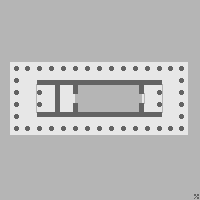Cella

A cella (from
Greek and Roman temples

In ancient
The cella was typically a simple, windowless, rectangular room with a door or open entrance at the front behind a colonnaded portico facade. In larger temples, the cella was typically divided by two colonnades into a central nave flanked by two aisles. A cella may also contain an adyton, an inner area restricted to access by the priests—in religions that had a consecrated priesthood—or by the temple guard.
With very few exceptions, Greek buildings were of a
Etruscan temples
According to
. This is an entirely new setup with respect to the other types of constructions found in Etruria and the Tyrrhenian side of Italy, which have one cell with or without columns, as seen in Greece and the Orient.Egyptian temples
In the Hellenistic culture of the Ptolemaic Kingdom in ancient Egypt, the cella referred to that which is hidden and unknown inside the inner sanctum of an Egyptian temple, existing in complete darkness, meant to symbolize the state of the universe before the act of creation. The cella, also called the naos, holds many box-like shrines. The Greek word "naos" has been extended by archaeologists to describe the central room of the pyramids. Towards the end of the Old Kingdom, naos construction went from being subterranean to being built directly into the pyramid, above ground. The naos was surrounded by many different paths and rooms, many used to confuse and divert thieves and grave robbers.
Christian churches
In early Christian and Byzantine architecture, the cella or naos is an area at the center of the church reserved for performing the liturgy.
In later periods a small chapel or monk's cell was also called a cella. This is the source of the Irish language cill or cell (Anglicised as Kil(l)-) in many Irish place names.
See also
- List of Greco-Roman roofs
References
- ISBN 0674015177.
- ISBN 0567089436.
- ^ a b Chisholm 1911.
- ^ "Vitruvius, De architectura, Book IV, Chapter 7". Archived from the original on 2006-01-13. Retrieved 2005-12-18.
Bibliography
- This article incorporates text from a publication now in the public domain: Chisholm, Hugh, ed. (1911). "Cella". Encyclopædia Britannica. Vol. 5 (11th ed.). Cambridge University Press. p. 604.
- Trachtenberg and Hyman, Architecture: From Prehistory to Post Modernity (second edition).
External links
- Vitruvius, De architectura, Book IV. ch 7 : translation, plans and reconstructions of Tuscan cellae Archived 2006-01-13 at the Wayback Machine
